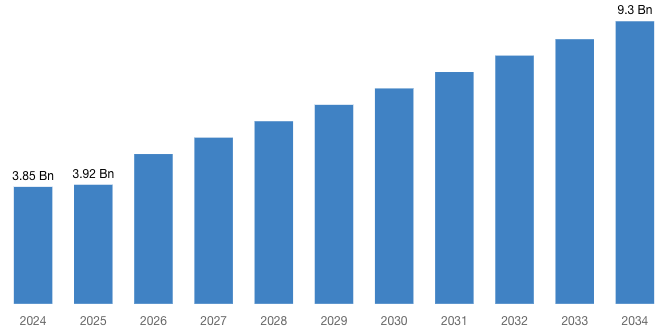Austin, TX, USA, Oct. 01, 2025 (GLOBE NEWSWIRE) — Custom Market Insights has published a new research report titled “Hospital Capacity Management Solutions Market Size, Trends and Insights By Solution Type (Capacity Management Software, Capacity Planning Software, Patient Flow Management, Others), By Hospital Type (Public Hospitals, Private Hospitals, Specialty Hospitals, Teaching Hospitals, Children’s Hospitals), By Workflow (Pre-Admission, During Admission, Post-Discharge, End-to-End), By Deployment Model (Cloud-Based, On-Premise), and By Region – Global Industry Overview, Statistical Data, Competitive Analysis, Share, Outlook, and Forecast 2025 – 2034“ in its research database.
“According to the latest research study, the demand of the global Hospital Capacity Management Solutions Market size & share was valued at approximately USD 3.85 Billion in 2024 and is expected to reach USD 3.92 Billion in 2025 and is expected to reach a value of around USD 9.3 Billion by 2034, at a compound annual growth rate (CAGR) of about 10.4% during the forecast period 2025 to 2034.”
Click Here to Access a Free Sample Report of the Global Hospital Capacity Management Solutions Market @ https://www.custommarketinsights.com/request-for-free-sample/?reportid=74249
Overview
The market for hospital capacity management is experiencing gradual growth, according to industry experts at CMI, due to the increasing demand for operational efficiency, streamlined patient flow, and resource optimization in hospitals, specialty clinics, and research facilities. Such major participants as Cerner, GE Healthcare, Epic Systems, Allscripts, and McKesson are advancing their automation, predictive analytics, and cloud-based dashboards. North America prioritizes regulations, modern hospital facilities, and intelligent capacity planning, while Europe focuses on energy-efficient and environmentally friendly hospital operations.
The Asia-Pacific market is becoming the fastest growing market with the growth of healthcare infrastructure, government programs, and the implementation of scalable and AI-enabled healthcare solutions. The interactions between technology providers and a combination of hospitals and research organizations are increasing operational competence and global competitiveness in the market.
Key Trends & Drivers
- Growing Healthcare Demand: The growing worldwide patient rates, the trend of aging, and the number of patients with chronic conditions are forcing hospitals to maximize bed rates, patient throughput, and the allocation of resources. The solutions to hospital capacity management allow for real-time control, effective scheduling, and better usage of staff and equipment so that they can provide better care to patients and decrease an increase in bottlenecks within high-demand healthcare settings.
- Technological Advancements: The implementation of AI, IoT, predictive analytics, and cloud-based platform types is transforming the operations in the hospital. These technologies can be used to track patients, resources, and equipment in an automated manner, offer data-driven insights to inform a decision, and minimize the error of mistakes. Improved connectivity and real-time analytics will help hospitals to work more efficiently and enhance throughput and the overall quality of care.
Request a Customized Copy of the Hospital Capacity Management Solutions Market Report @ https://www.custommarketinsights.com/request-for-customization/?reportid=74249
- Regulatory Compliance and Sustainability: Hospitals are pressured to conform to high postulates of regulation and sustainability. Capacity management solutions will be beneficial in meeting the health and safety standards, reducing the level of electricity consumption, and utilizingresources efficiently. Hospitals can achieve ESG goals and enhance the transparency and accountability of their operations by implementing environmentally friendly and efficient processes.
Report Scope
| Feature of the Report | Details |
| Market Size in 2025 | USD 3.92 Billion |
| Projected Market Size in 2034 | USD 9.3 Billion |
| Market Size in 2024 | USD 3.85 Billion |
| CAGR Growth Rate | 10.4% CAGR |
| Base Year | 2024 |
| Forecast Period | 2025-2034 |
| Key Segment | By Solution Type, Hospital Type, Workflow, Deployment Model and Region |
| Report Coverage | Revenue Estimation and Forecast, Company Profile, Competitive Landscape, Growth Factors and Recent Trends |
| Regional Scope | North America, Europe, Asia Pacific, Middle East & Africa, and South & Central America |
| Buying Options | Request tailored purchasing options to fulfil your requirements for research. |
(A free sample of the Hospital Capacity Management Solutions report is available upon request; please contact us for more information.)
Our Free Sample Report Consists of the following:
- The updated report for 2025 includes an introduction, an overview, and an in-depth industry analysis.
- Provide detailed chapter-by-chapter guidance on the Request.
- Updated Regional Analysis with a Graphical Representation of Size, Share, and Trends for the Year 2025
- Includes Tables and figures have been updated.
- The most recent version of the report includes the Top Market Players, their Business Strategies, Sales Volume, and Revenue Analysis
- Custom Market Insights (CMI) research methodology
(Please note that the sample of the Hospital Capacity Management Solutions report has been modified to include the COVID-19 impact study prior to delivery.)
Request a Customized Copy of the Hospital Capacity Management Solutions Market Report @ https://www.custommarketinsights.com/report/hospital-capacity-management-solutions-market/
SWOT Analysis
- Strength: Hospital capacity management solutions enhance the quality of operations, patient flow, and resource distribution. Predictive analytics based on AI, IoT-powered monitoring, and cloud-based solutions facilitate real-time decision-making, lessen congestion, and assist with regulatory compliance. High market adoption in North America and Europe builds credibility in the market, and sophisticated features guarantee sustainability and high ROI.
- Weaknesses: It is costly to implement and maintain, and this makes its adoption in small and mid-sized hospitals a limitation. This integration may be complicated with the legacy hospital systems and needs a significant amount of staff training. Reliance on IT infrastructure and data security measures can form weak points, whereas the need to customize different hospital processes can slow down implementation and make operations more difficult.
- Opportunities: The growth of …

